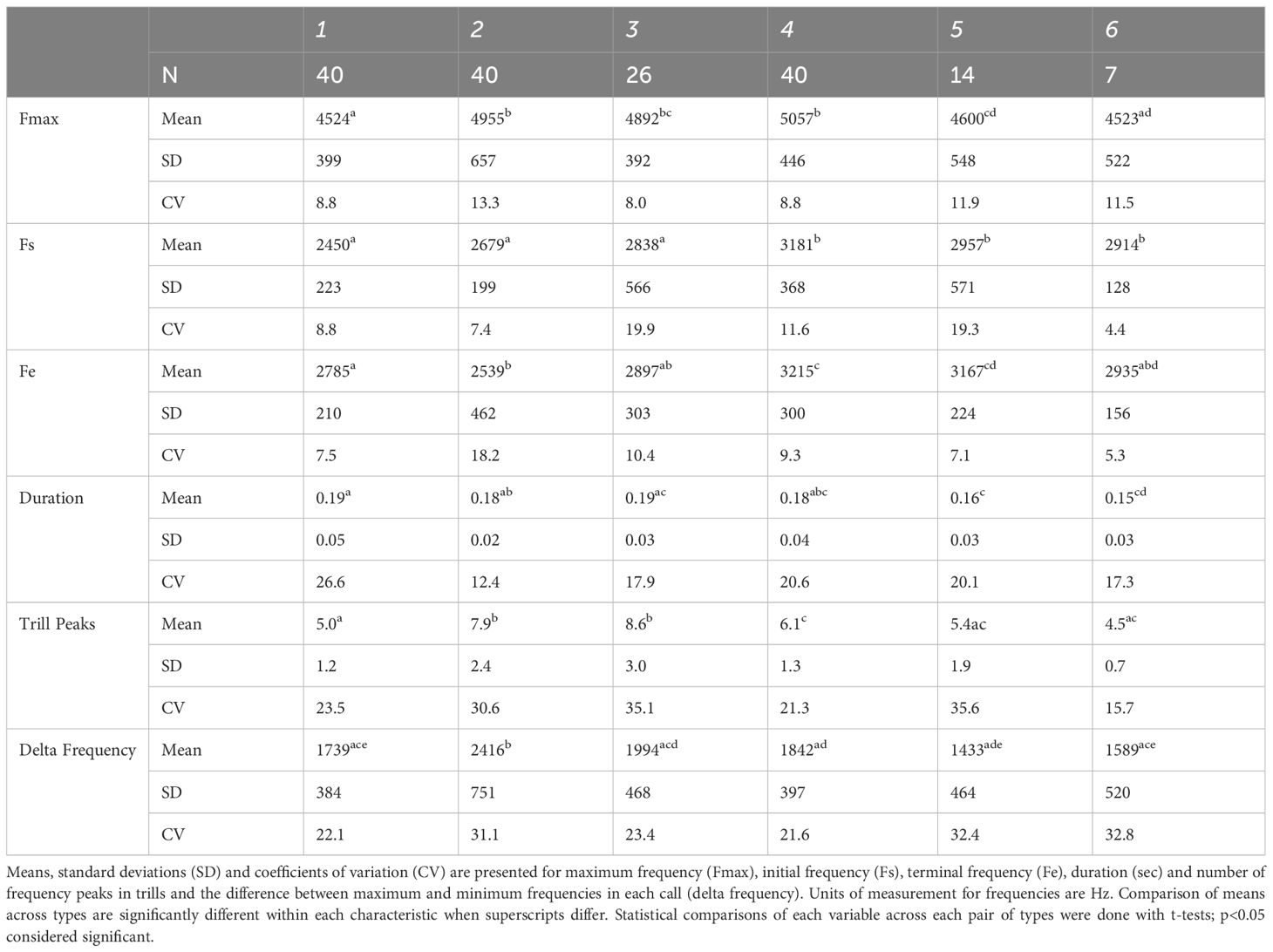- 1Department of Fisheries, Wildlife and Conservation Sciences, Oregon State University, Corvallis, OR, United States
- 2Interlake High School, Bellevue, WA, United States
- 3Finch Research Network, Cincinattus, NY, United States
- 4Department of Neurobiology, Physiology and Behavior, University of California, Davis, Davis, CA, United States
Diversity within species can be masked by minor differences in external appearance but revealed by group differences in vocal characteristics such as flight calls of Fringillid finches. These flight calls vary among infraspecific groups within a species. In Evening Grosbeaks (Coccothraustes vespertinus), existence of five distinct call types have been hypothesized to occur, yet the variation within and between the different call types has yet to be quantitatively evaluated. We measured characteristics of flight calls and another common call form, trills, across the North American range of the Evening Grosbeak. We analyzed our own recordings as well as those contributed to digital sound archives to map, measure and, with the aid of cluster and discriminant function analyses, classify flight calls and trills into types. Flight calls of types 1, 2, 3, and 4 were readily distinguishable from each other but trills were less distinctive. A fifth set of calls that group together in cluster analyses includes birds from the southwestern United States, Mexico and, surprisingly, from Alberta and Saskatchewan, Canada. However, flight calls from central Canada and Mexico/Arizona still showed several statistically significant differences, so we hypothesize existence of six flight call types. Our interpretation may be influenced by currently small sample sizes and lack of summer samples from Mexico. Here, we refer to the Mexico/Arizona birds as type 5 and the Alberta and Saskatchewan birds as type 6 but recognize that additional information could provide stronger evaluation of these categories. Except for some type 3, 4 and 6 flight calls that were very similar according to the spectrographic properties included in our analyses, most Evening Grosbeak flight calls are diagnosable to type with a high degree of confidence. We encourage additional collection of recordings across North America, especially from central Canada, Arizona, and Mexico. Future studies can utilize sound recordings to identify infraspecific call type groups, map their seasonal movements and investigate variation in call structure through time to facilitate progress toward unraveling the evolutionary importance of such cryptic diversity.
1 Introduction
Studies of avian diversity commonly rely on external features, i.e., field marks, to identify birds. Most studies focus on determination of species identities, yet some well-marked species have recognizable infraspecific diversity, or subspecies, which may provide clues about cohesive evolutionary histories of populations subsumed within currently recognized species (Toews and Irwin, 2008; Hending, 2025). At the same time, more species have been recognized as possessing infraspecific diversity in vocal characteristics while maintaining virtually identical external field marks (Jones, 1997). This cryptic diversity where plumages are nearly identical, yet different subspecific level groups or populations have consistently recognizably different calls are referred to as “call types” and occur frequently in the family Fringillidae (finches) (Groth, 1988, 1993).
Fringillid finches are an especially interesting group to study owing to the nomadic behavior of some species, which can sometimes lead to extensive overlap in geographic ranges of call types. A particularly well studied example is the Red Crossbill (Loxia curvirostra), in which over three decades of study has uncovered at least twelve call types in North America and many in Eurasia, most of which wander widely in search of conifer cone crops (Groth, 1988, 1993; Young et al., 2024). These call types have been recognized based on assumptions that all members of a call type population give the same recognizable call throughout the year and that this call stays consistent throughout each individual’s lifetime (Keenan and Benkman, 2008; Sewall and Hahn, 2009). When those assumptions are true, the geographic ranges and temporal movements of the nomadic finches can be documented with sound recordings (Robinson et al., 2024).
The recent growth of community-sourced sound recording archives such as the Macaulay Library and xeno-canto.org has encouraged thousands of birders to upload recordings of bird calls, allowing researchers to identify finch recordings to specific call types, to map ranges and to track movements through time (Robinson et al., 2024; Young et al., 2024). Because birds of specific call types normally cannot be identified visually in the field, the availability of recordings has revealed new insights. For example, while Cassia Crossbills (Loxia sinesciurus; formerly Red Crossbill Type 9) are clearly relatively sedentary compared with other western call types, and display evidence of morphological local adaptation within a small core range in southern Idaho (Benkman et al., 2009; Benkman, 2016), community-sourced recordings uploaded to the eBird database (Sullivan et al., 2009; Wood et al., 2011) have documented Cassia Crossbills wandering and potentially breeding in several western US States as far as Colorado and California, more than 1000 km from their core range. This influx of community-sourced and independently verifiable data allows researchers to reconsider former assumptions about call type populations and make new discoveries regarding their diversity.
As with Red Crossbills, Evening Grosbeaks (Coccothraustes vespertinus) have call types (Sewall et al., 2004). Evening Grosbeak calls are divided into two primary forms. Flight calls are given by Evening Grosbeaks both while flying and while perched. Flight calls are usually single notes lasting 0.1 to 0.25 seconds with a frequency sweep that increases rapidly then decreases. Depending on the call types, such flight calls can be pure in tone or contain extremely rapid frequency modulations that give the calls a burry or buzzy sound. The second common call form, trills, also contains frequency cycles but the periodicity of cycles is longer (fewer peaks per unit time), making trills sound distinctly different from flight calls. Trills do not usually range across the same magnitude of frequency variation as do flight calls and tend to be longer in duration than flight calls. The trills of types 1 and 2 are diagnosably different from each other and can be used to identify birds to call type (Robinson et al., 2024) but no analyses of trills of the other Evening Grosbeak call types have been undertaken.
Four call types of Evening Grosbeaks were proposed by Sewall et al. (2004) based on visual inspection of flight call spectrographic properties. Type 1, which breeds largely in the Pacific Northwest, and type 2, breeding in the Sierra Nevada Mountains, are readily identifiable by distinctly different call structures (Robinson et al., 2024). Type 3, breeding across forests of Canada from Alberta to Newfoundland, and type 4, occurring largely in the central and southern Rocky Mountains, USA, have been recognized as distinct types but no formal quantitative analyses have evaluated their diagnosability as compared with the other types. A fifth type was hypothesized based on one unusual recording obtained in May 1999 in the Huachuca Mountains, Arizona, USA. Yet, no formal quantitative analyses of the structure of flight calls has been conducted to ascertain the distinctiveness of the call types proposed by earlier authors. Interestingly, while Red Crossbill call type populations may breed sympatrically and will nest even during winter if food resources are abundant (Benkman, 1990), Evening Grosbeak call type populations appear largely allopatric and are only known to breed during their spring/summer breeding season (Scott and Bekoff, 1991). Furthermore, Evening Grosbeak call type population breeding ranges appear to be relatively stable over time, although centers of abundance may fluctuate through time (Sewall et al., 2004; Duman and Hahn, 2024). The hypothesized call types largely align with Grinnell’s morphological analysis of Evening Grosbeaks, in which he proposed five distinct subspecies (Grinnell, 1917). However, both Sewall et al. (2004) and Grinnell (1917) stated a need for further spatial and temporal coverage of recordings and specimens to fully resolve analyses.
Further analyses of call types are important as the rapidly increasing availability of recordings from across North America may reveal additional call types previously overlooked (Young et al., 2024). In addition, calls are learned in Fringillids (Mundinger, 1979), so there is potential for substantial variation in call characteristics within call types, which could make identification challenging (Robinson et al., 2024). Accurately documenting and identifying different call type groups is important for uncovering movement patterns, breeding areas, or ecological differences (e.g. dietary preferences, habitat selection) across types as well as cultural and evolutionary changes in sounds through time.
Here, we analyzed more than 200 recordings of Evening Grosbeak flight calls and trills to quantitatively characterize the structural elements of all hypothesized types and to evaluate potential occurrence of previously unrecognized call types. We focused on spectrographic characteristics easily measurable with freely available software to facilitate accurate diagnoses to call type by community scientists. Accurate identification assumes that flight calls maintain consistently recognizable characteristics through time, so we also compared spectrographic traits in recent versus older recordings.
2 Methods
2.1 Recordings
We downloaded recordings archived in the Macaulay Library (Sullivan et al., 2009; Wood et al., 2011) and xeno-canto.org to measure Evening Grosbeak flight calls and trills across North America. We focused on recordings obtained during the breeding season (May to August) to facilitate mapping birds in their breeding ranges but included some recordings outside those months to increase diversity of samples for types uncommonly represented in digital archives (e.g., recordings from Mexico). We randomly chose calls to measure within each recording with the constraints that exemplars had to be of sufficient quality to allow measurement of all characteristics of interest and were not obscured by overlap with other calls (Supplemental material for Data Files).
We used Raven Pro 1.6 or RavenLite (Cornell Lab of Ornithology, 2023) to measure several spectrographic properties including duration (s), beginning frequency (Hz), maximum frequency, end frequency and time at each (Figure 1). Most recordings had sample rates of at least 12 kHz. Although use of community-sourced recordings limits standardization of spectrogram parameters, we only utilized calls when we subjectively determined that sufficient detail was preserved to provide opportunities for accurate measurements. We measured spectrograms by cursor (sample size, FFT length= 512 points, frame size 100%, overlap 50%, frequency resolution (varied depending on sampling rate of recorder device), temporal resolution typically 2 ms, Hann window). We also noted whether flight calls were pure in tone or not, where we defined pure as the spectrograph showing a highly constrained whistled note lacking in frequency fluctuations that, if present, would render a burry or buzzy element to the calls. We noted presence or absence of harmonics but did not count the number of harmonics because differences in recording quality appeared to influence the reliability of counts. Some calls possessed abrupt and very brief downward shifts in frequency where the frequency dropped halfway or nearly to the same value as the terminal frequency in the call. We called these abrupt frequency shifts glitches. The time at which glitches occurred was noted so we could calculate the relative position within each call. That is, glitches occurring early in a call had glitch position closer to 0 while those occurring later had values closer to 1.
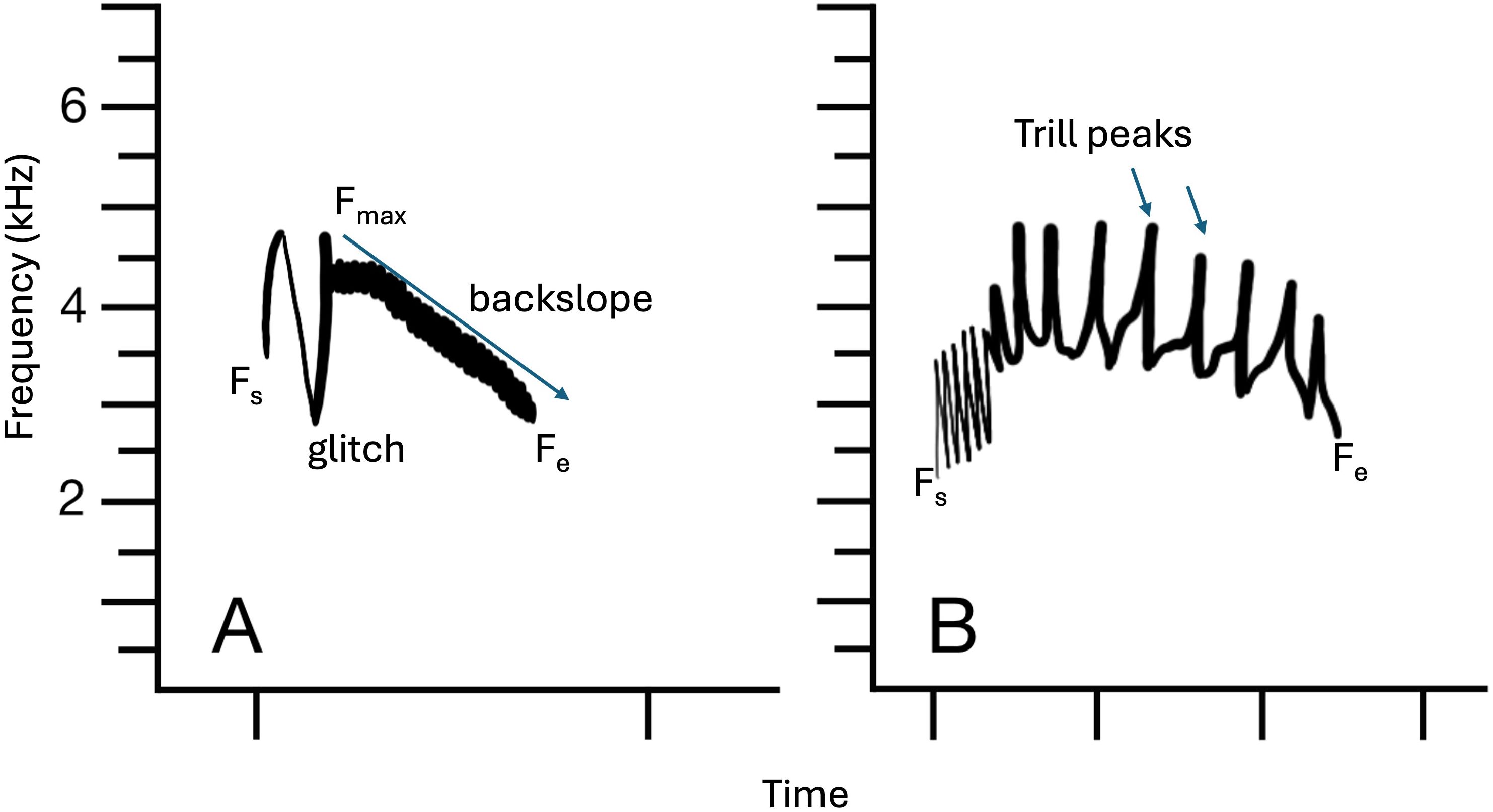
Figure 1. Illustrations of a flight call (A) and a trill (B) from Evening Grosbeaks. Vocabulary associated with some of the key structural features we measured in each recording are noted. Abbreviations: Maximum frequency (Fmax), starting frequency (Fs) and ending frequency (Fe).
We derived other characteristics from our initial set of measurements. Asymmetry denoted the relative distribution of each flight call occurring prior to the maximum frequency peak versus after that peak so values closer to zero indicate little of the call occurred before the peak while values closer to 0.5 indicated more equal distribution of the call before and after the peak. Some flight calls dropped in frequency faster toward the end of the call than did others, so we also calculated the straight-line slope from maximum to terminal frequencies. For trills, we measured duration, change in frequency, maximum frequency, beginning frequency, end frequency, and number of trill peaks for each recording. Trill peaks were the number of times each frequency cycle reached its maximum value within each call.
To characterize measurement error, we randomly selected 22 recordings of flight calls for repeat measurements (Supplementary Table 1). Paired t-tests revealed no significant differences (p<0.05), so measurement error was insufficient to affect our conclusions.
2.2 Data analysis
We compared means of traits across call types (flight calls and trills separately) with paired t-tests or Wilcoxon tests depending on alignment with distributional assumptions. Specifically, flight call asymmetry, glitch positions and slopes did not meet distributional assumptions of t-tests, so we used the nonparametric Wilcoxon test to compare pairs of types.
We used hierarchical cluster analysis (Ward’s method) to identify types based on similar configurations of call characteristics. For flight calls, we included initial, maximum and terminal frequencies, duration, count of harmonics (0 or 1), glitch position, asymmetry, and slope. For trills we included initial, maximum and terminal frequencies, duration, and number of trill peaks. We did these analyses without reference to previously determined call type assignments (recordists or reviewers of sound submissions often assigned calls to type during the archival process and its review) to allow the clustering algorithm to recognize similarities based only on spectrographic properties and our derived measurements. Each call was labeled with its originally assigned call type so we could visually evaluate patterns in the cluster analyses, but that information was excluded from the statistical analyses. We then inspected each call that appeared to be incorrectly assigned to type to determine if it was originally misidentified and we remeasured its characteristics to check for errors. After correcting errors (type was incorrectly assigned in the digital archive in about 3% of cases), we re-ran the cluster analysis for final assessment of objectively defined clusters.
We performed linear discriminant function analyses on characteristics of flight calls and trills to assess the degree to which calls could be correctly assigned a call type. All statistical analyses were done with JMP Pro 17 (JMP, 2023).
2.3 Mapping the geography of breeding season ranges
We mapped the breeding season geographic ranges of Evening Grosbeak call types by plotting in ArcGIS Pro Version 3.2.0 (Esri, Inc., 2022) the latitude and longitude of all recordings archived in the Macaulay Library up through 2024 during June-July (n=307, supplemental material for data files) that could be identified to call type. We only used recordings from June and July here as this timeframe is less likely to include pre-breeding or post-breeding wanders, and more accurately reflects the geographic partitioning of the call types’ breeding ranges.
3 Results
We analyzed 239 flight calls and 167 trills across the North American range of the Evening Grosbeak. Recordings were most available from the west (ranges of types 1, 2 and 4), followed by Canada (mostly type 3) with a few recordings from Veracruz and Oaxaca states, Mexico (Figure 2).
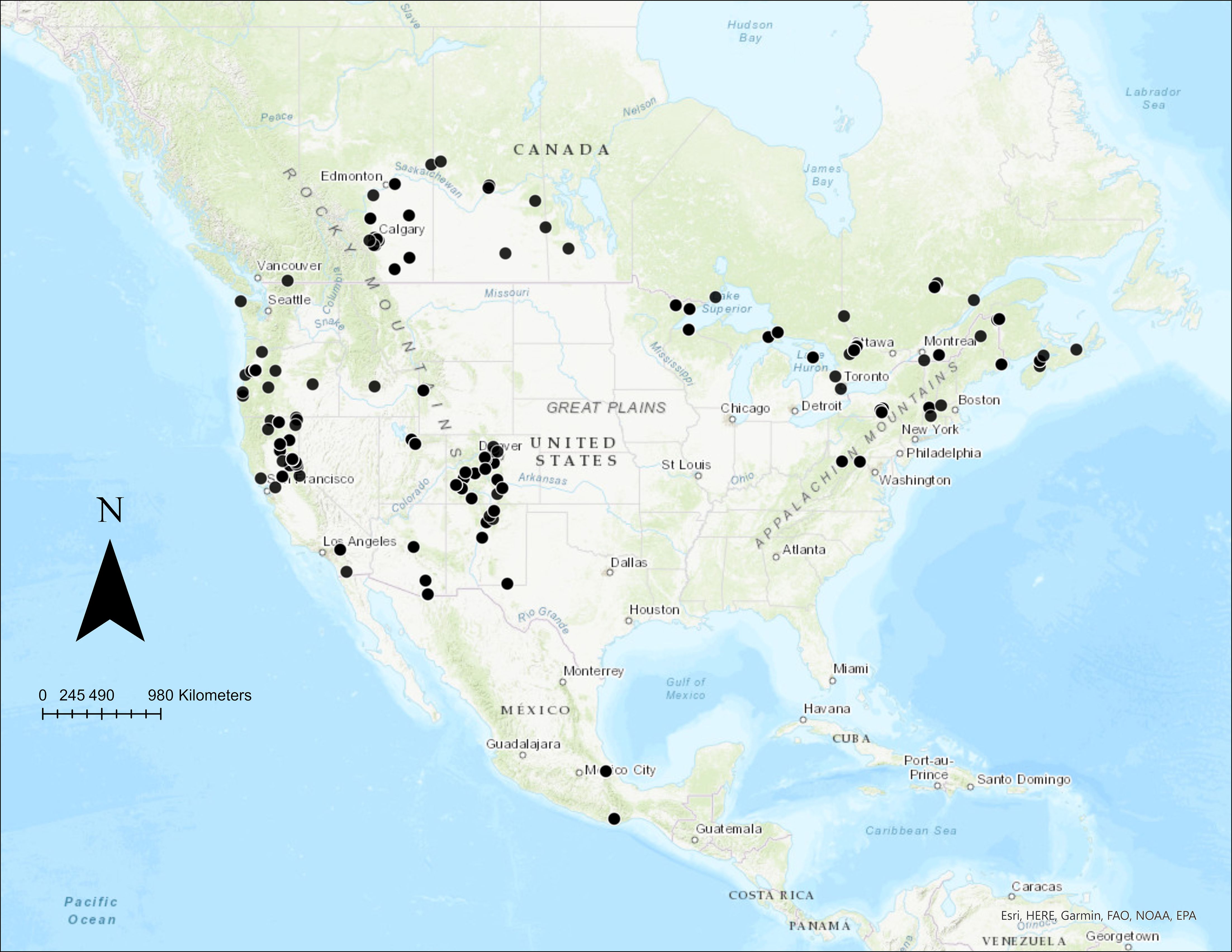
Figure 2. Map of spatial coverage of measured Evening Grosbeak recordings across North America. Recordings were limited in availability for most of Mexico and in central Canada during both the breeding season and for the remainder of the year.
Hierarchical cluster analyses identified six groups of flight calls (Figure 3). Some aligned with previously recognized types, including types 1-4. However, type 3 calls were distributed across two distinct clusters, one of birds recorded after the year 2000 and another of birds recorded earlier. The older type 3 recordings clustered with a subset of type 4 birds. Type 5 (the one Arizona recording and the Mexico recordings) clustered within a sixth group that was largely represented by recordings from Alberta and Saskatchewan, Canada, which we consider tentatively as type 6.
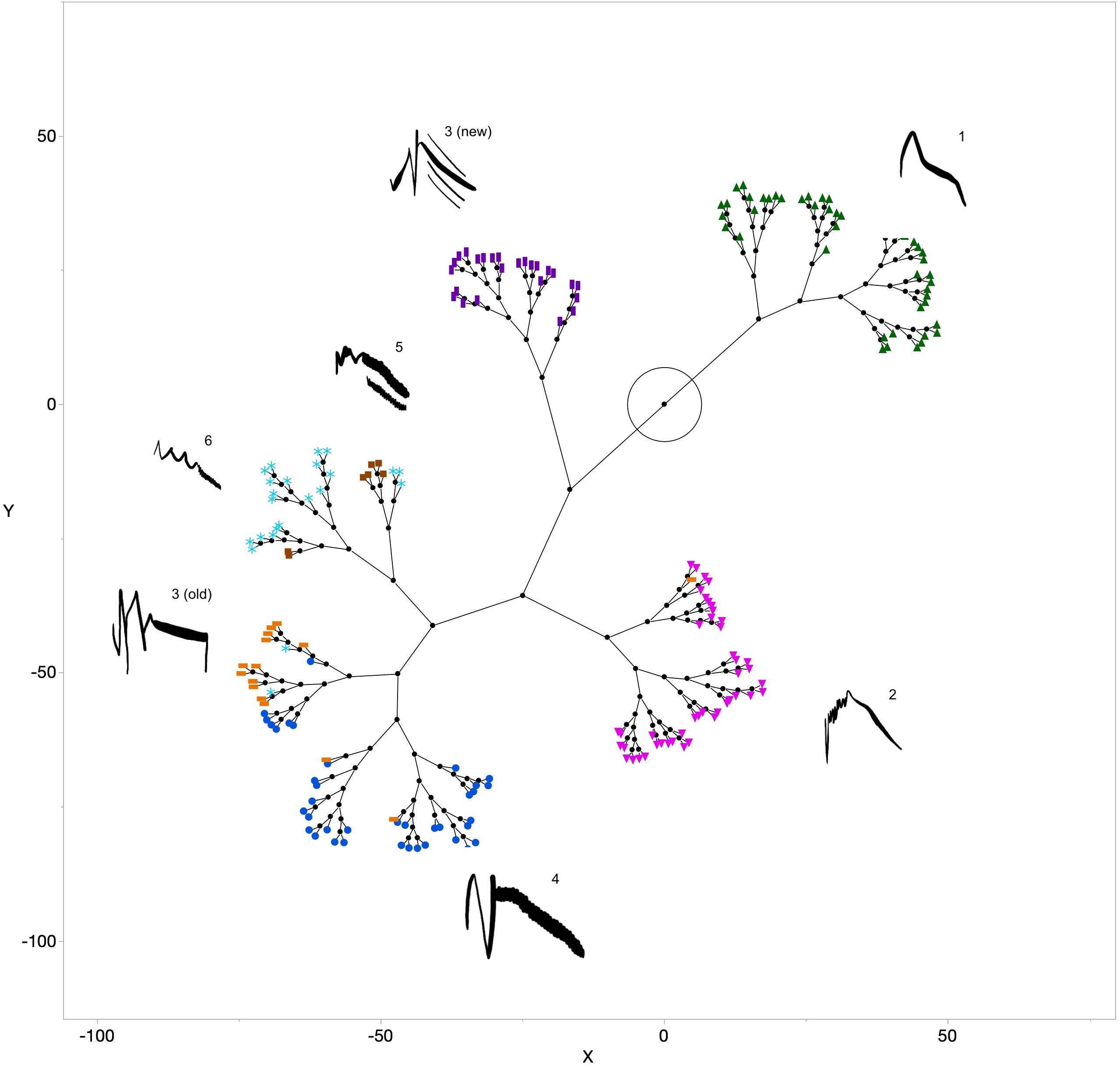
Figure 3. Hierarchical clustering constellation plot of flight call characteristics. Typical flight call structures are illustrated next to Type 1 (green triangles), type 2 (pink triangles), type 3 (old=before the year 2000: orange horizontal rectangles; new=after 2000: purple vertical rectangles), type 4 (dark blue circles), type 5 (brown squares) and type 6 (light blue asterisks).
Spectrographic properties of flight calls were sufficiently variable across the types that some statistically significant difference was apparent for all properties we measured (Table 1). Type 1 flight calls tended to initiate at a higher frequency, were shorter in duration, had most of the call content after reaching maximum frequency and declined in frequency more rapidly than most of the other call types. They were also quite variable in shape as indicated by the highest coefficient of variation in symmetry measurements of all the types. Types 2 and 4 were similar in shape, appearing as convex “overslurs” with the starting and ending frequencies being approximately equal (Figure 4). Type 2 was the longest in duration of all call types by 0.03-0.07 sec on average. Type 2 differed from type 4 in typically lacking a glitch, which type 4 appeared to always contain and was typically positioned one-fifth to one-quarter of the way into its highly symmetrically shaped flight call. Type 2 also reached, on average, a higher maximum frequency than the other call types and tended strongly to have the largest asymmetry value of the call types with convex shapes.
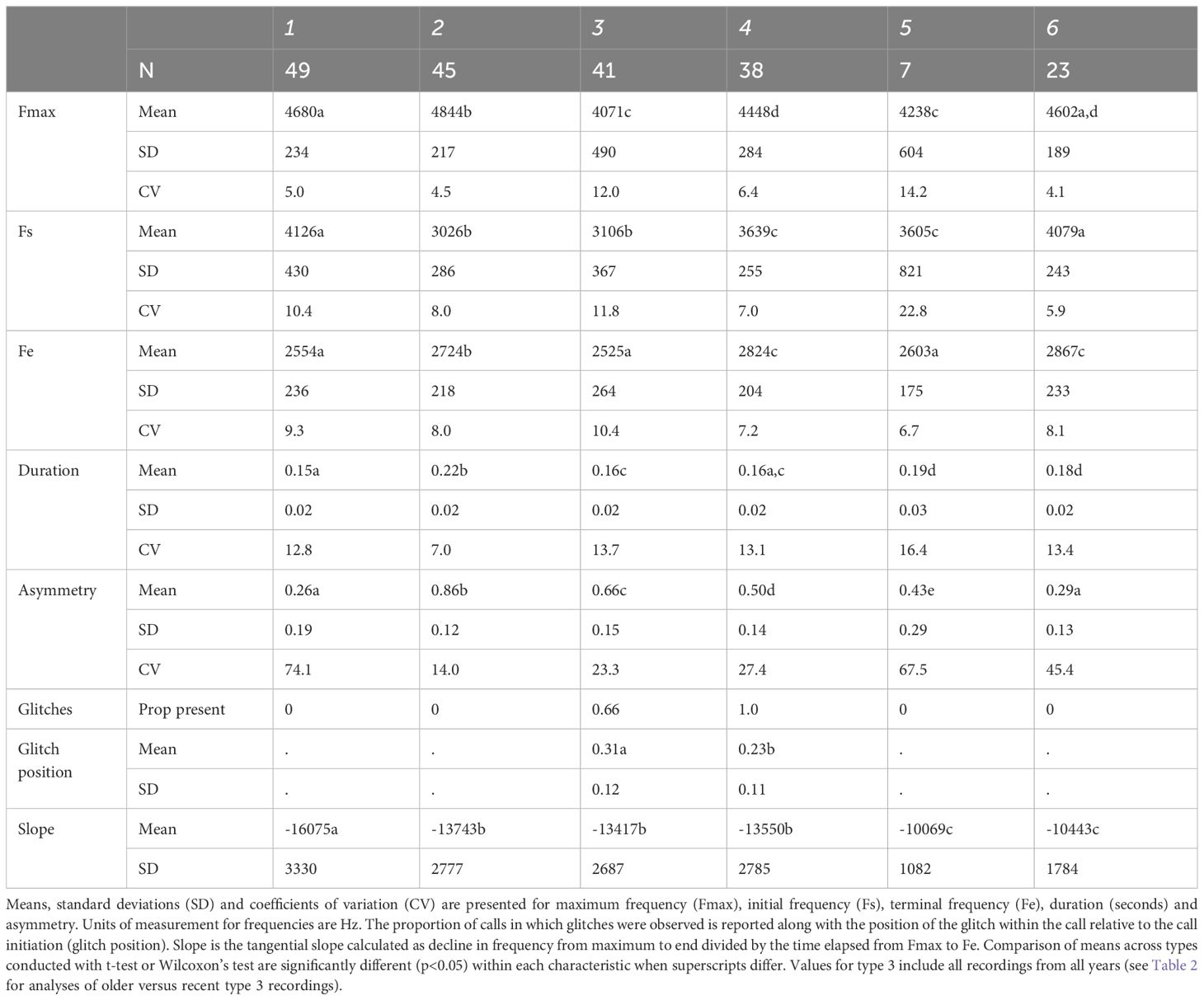
Table 1. Characteristics of Evening Grosbeak flight calls across the 4 currently recognized types and two potentially distinct types, Mexico/Arizona (putative type 5) birds and Alberta/Saskatchewan (putative type 6) birds.
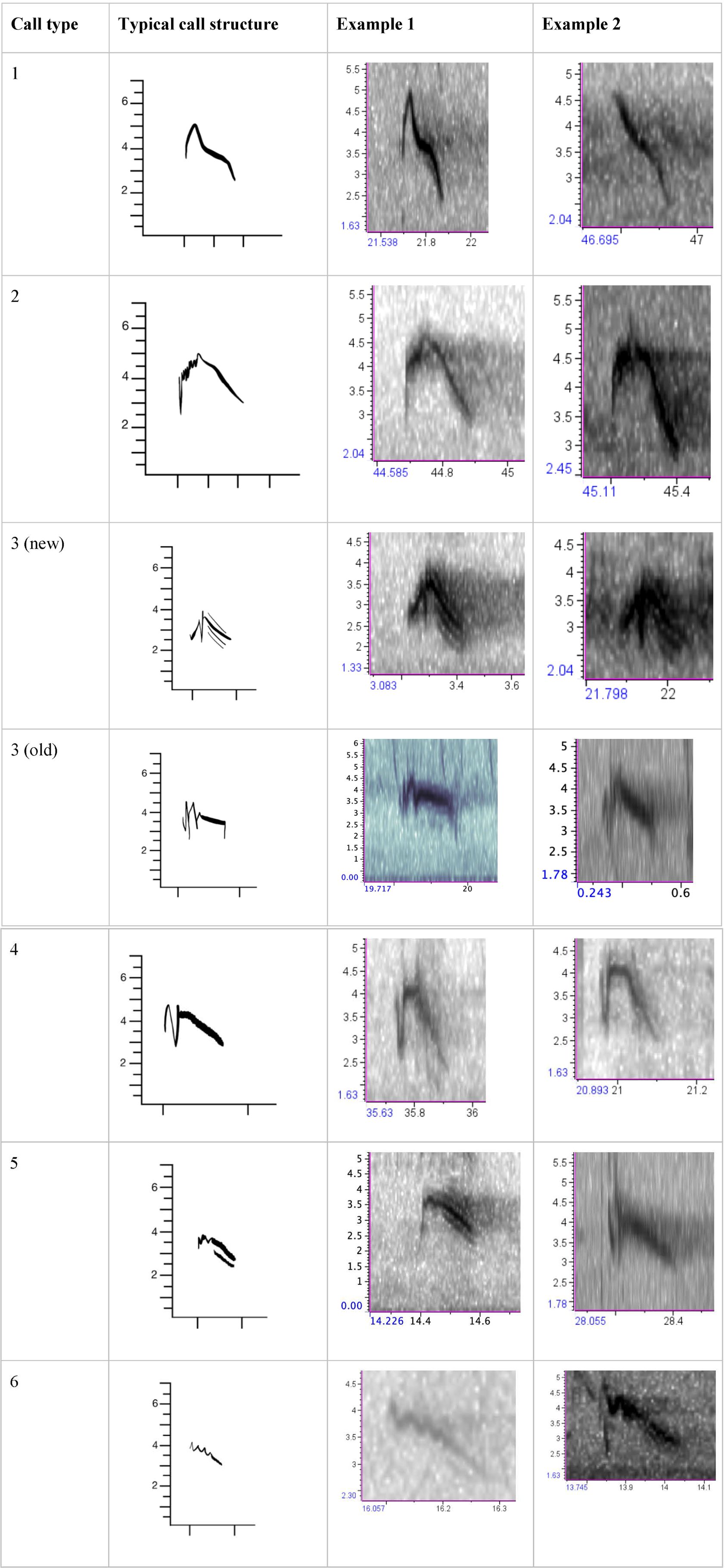
Figure 4. Example spectrograms of flight calls of the types of Evening Grosbeaks. In each image, the x-axis is time (s) and y-axis is frequency (kHz). The left column includes drawings of “typical” call structures for each type to illustrate the key shape and structural features. The middle and right columns provide examples from screen captures.
Discriminant function analyses of the 7 clusters (with old and recent 3s separated into two groups [see below]) classified flight calls in alignment with our assignments 79.6% of the time (entropy r-squared 0.70). Classification accuracy declined from 98% accuracy for type 2 birds to 94% for type 1, 93% for recent type 3, 79% for type 4, 63% for type 6, 63% for type 5 and 43% for older type 3. Thus, results largely aligned with the cluster analyses where the variables we measured struggled to discriminate among old type 3 and some calls labeled as types 4, 5 or 6. Overall, types 1, 2 and recent type 3 are highly diagnosable, while characteristics of the other types overlap enough that careful inspection is required to assign birds correctly to call type.
3.1 Variation through time in type 3 calls
Characteristics of type 3 birds were complicated by apparent change in characteristics through time (Figure 5). Calls prior to the year 2000 were higher in initial and maximum frequencies, longer in duration, more symmetrically shaped, less likely to contain a glitch and, if present, the glitch was positioned earlier in the call (Table 2). The older type 3s were also more steeply sloped on the terminal section of the call than were calls after 2000. We saw no evidence of geographic sampling bias that may have affected the analyses as geographic locations of recordings analyzed overlapped extensively. No other flight calls showed temporal changes of similar magnitude. Exceptions were type 2 calls, which increased in duration through the years (starting in the early 1990s) from 0.2 to 0.23 sec (r-squared 0.29, F=17.3, p<0.0001) and type 4 calls became more symmetrical in shape, on average (r-squared = 0.12 and F=5.0, p=0.032).
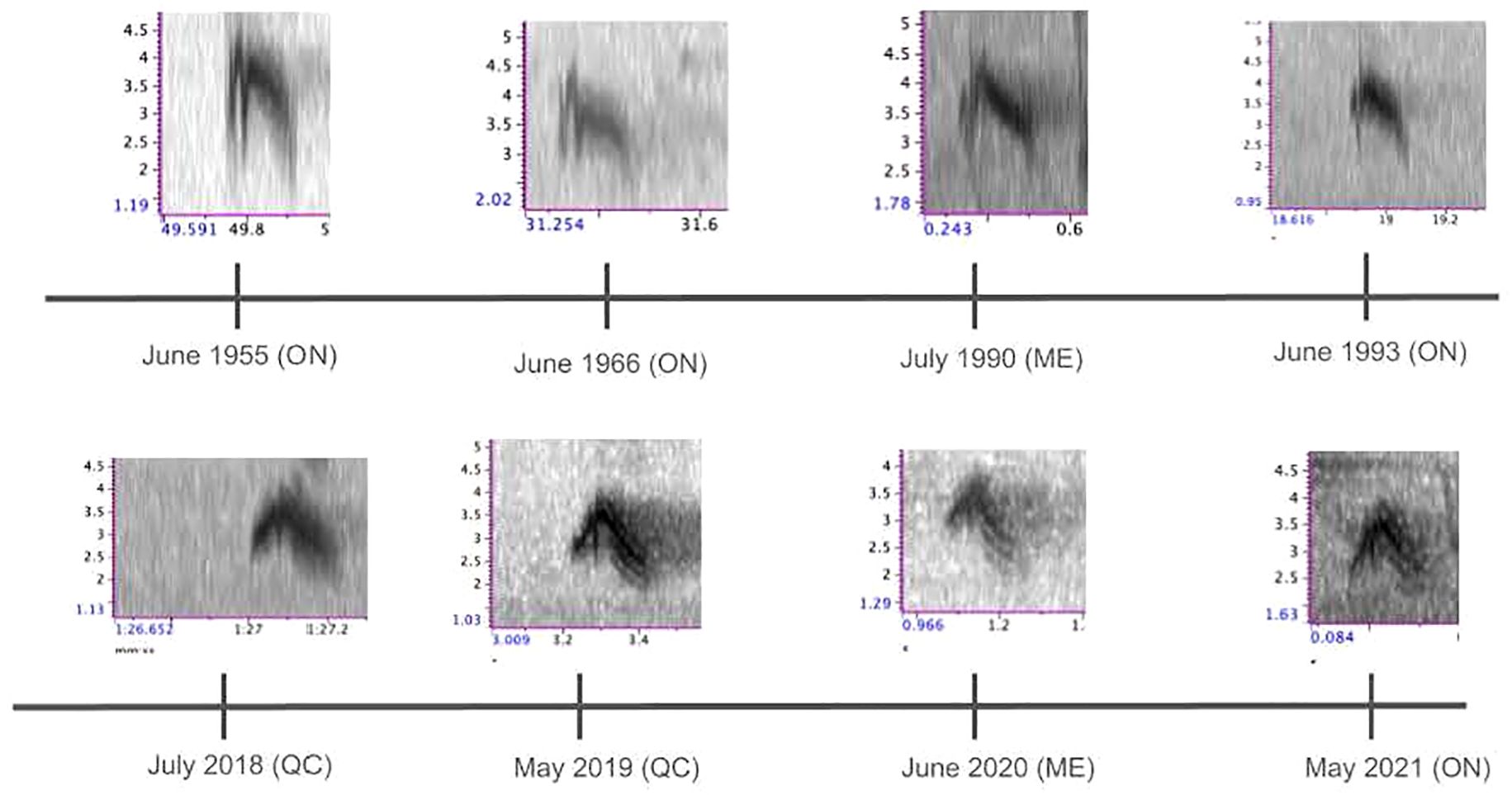
Figure 5. Change in structure and shape of type 3 calls over time. Sampling month and year along with general location (US state or Canadian province abbreviations) are included.
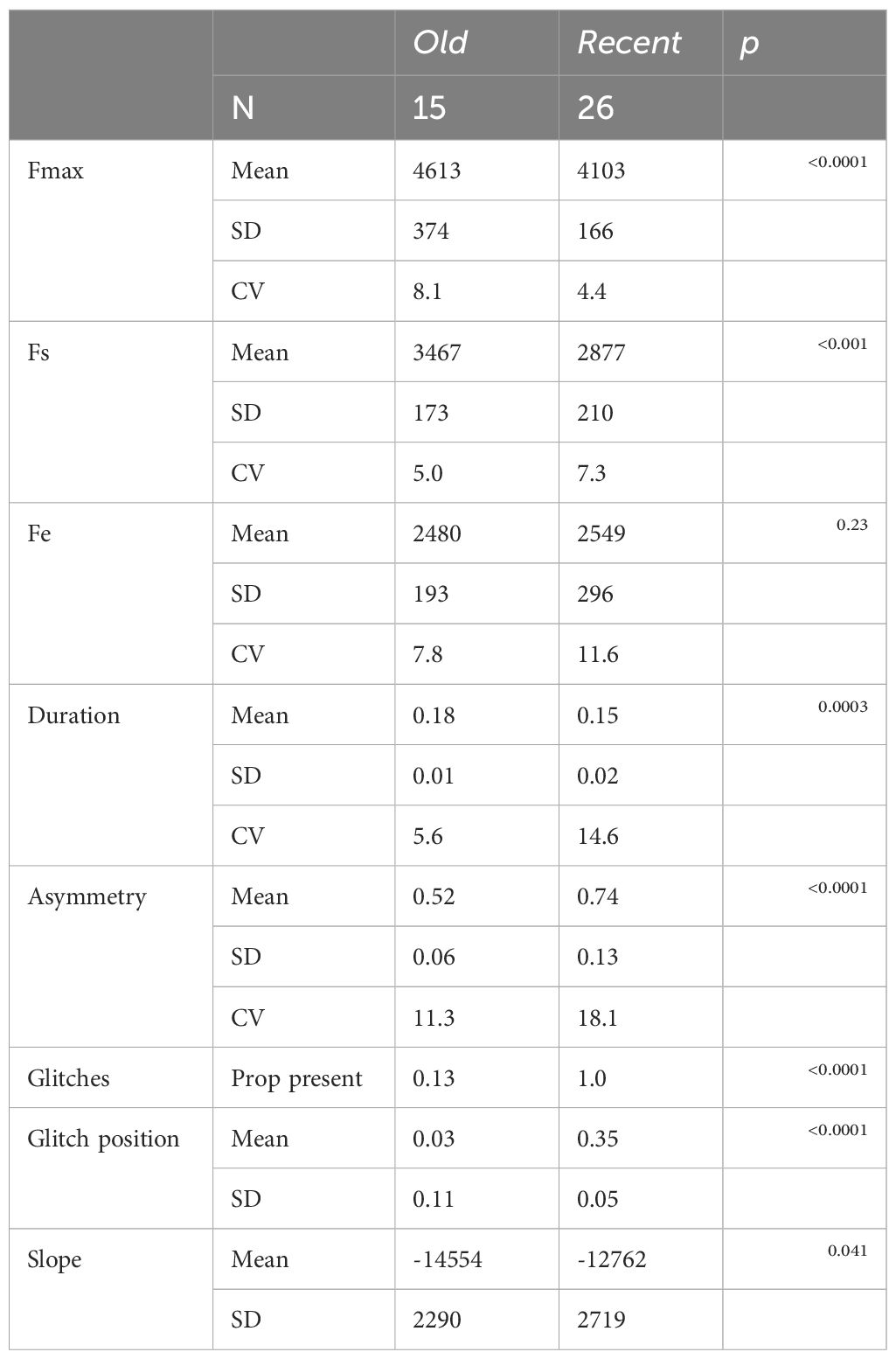
Table 2. Comparison of type 3 calls recorded before the year 2000 (old) and those recorded after (recent). Statistical comparisons were conducted with Wilcoxon tests.
3.2 Trills
Although previous work showed trills of call types 1 and 2 were readily distinguishable with discriminant function analyses based on a few traits (Robinson et al., 2024), the intermediate characteristics of trills in call types 3, 4, 5 and 6 rendered identification of trills by type to be unreliable. Visual examination shows variability across types but also many similarities (Supplementary Figure 2). Our lowest level of misclassification was 46% (entropy R-squared = 0.29) when we analyzed Fmax, Fend, duration and number of trill peaks together as variables. All other comparisons of different combinations of those traits produced even larger measurements of classification error. Thus, even though trills of types 1 versus 2 are separable, trills of types 3, 4, 5 and 6 are not consistently separable from each other based on characteristics we included in our recording samples. Nevertheless, trills of call type 1 can be reliably diagnosed from those of types 3 and 4 as trills of type 1 have lower Fmax and fewer peaks than trills of type 3 (Table 3). Furthermore, trills of call type 2 can be reliably separated from trills of types 4, 5 and 6 because of the generally lower starting, ending and maximum frequencies, and larger number of peaks in type 2 trills.
4 Discussion
4.1 Identification of call types
4.1.1 Flight calls
Based on our set of measured characteristics of flight calls, we hypothesize the occurrence of as many as 6 call types of Evening Grosbeaks in North America. We confirmed the reliable diagnosability of the 4 types recognized earlier (Sewall et al., 2004) and provided quantitative measurements to help characterize spectrographic properties of each type. Types 1 and 2 were distinctly different and recognizable from the other types. Type 1 is the only type with a consistently pure tone (constrained whistle) and is the most asymmetrical in shape with most call content being positioned after the maximum frequency is obtained. Type 2 is an overslur similar to the shape of type 4 and some type 3 flight calls but is longer in duration than any other types of flight calls. Type 2 also consistently lacks a glitch and harmonics.
We discovered two previously undescribed findings regarding Evening Grosbeak call types. First, type 3 call characteristics appear to have changed over time. Calls after 2000 cluster distinctly from pre-2000 calls: recent type 3 calls are symmetric overslurs with a glitch occurring about one-quarter into the call and one or more harmonics, whereas older recordings are more asymmetrical, feature an earlier glitch, generally lack harmonics, and have higher starting and maximum frequencies. In fact, the differences between older and recent type 3 calls exceed those observed between types 2 and 4. Moreover, the older type 3 calls cluster separately from, but are similar to, a subset of calls labeled as type 4. Their pattern of geographic occurrence aligns with the pattern shown by type 3 calls recorded after 2000, so we consider the most likely explanation to be that the call structure of type 3 birds has shifted over time, not that the older calls are type 4 birds. Bird vocalizations are known to vary in certain characteristics through time (Wilkins et al., 2013; Podos and Webster, 2022). For example, some Red Crossbill flight calls have shifted through time while song characteristics of many species also vary through time. Some of the variation has been attributed to cultural drift as small groups of breeding birds, such as neighborhoods of singing males (Borror, 1961; Lemon, 1975; Baptista, 1977), mimic each other’s vocalizations and adopt new variants within vocabularies (Slater, 1986). Flight calls are structurally simpler than most bird songs so detection of structural shifts has been rarely reported in ornithological literature. Although variation through time has been noticed in flight calls of Red Crossbills (Martin et al., 2019, 2020), we are unaware of any ecological explanations for those reported changes. Likewise, we do not yet understand why flight calls of type 3 Evening Grosbeaks would change so obviously through time while only minor shifts or no recognizable changes would have occurred in the other types during the same time period. As vocalizations are learned in many lineages of songbirds (Slater, 1989), and geographic isolation can lead to cultural drift in bird sound characteristics (Podos and Warren, 2007; Sebastian-Gonzalez and Perez-Granados, 2025), it is possible that past isolation of some subset of type 3 Evening Grosbeaks could have promoted such dramatic shifts in flight call characteristics. As type 3 Evening Grosbeaks appear to respond strongly to availability of spruce budworms during the breeding season and outbreaks of budworms are not uniformly distributed, one potential mechanism for promoting drift in calls is disruption in call structure when populations become fragmented and isolated long enough from other populations that new vocalizations arise and are quickly learned by offspring (Podos and Warren, 2007). Currently, we know of no evidence to support this hypothesis for Evening Grosbeaks but aligning past data on budworm outbreaks with recordings could reveal geographic and temporal concordance in structural shifts of calls.
Second, flight calls recorded primarily in Alberta and Saskatchewan form a distinct cluster that includes, on a separate branch, the type 5 calls from Arizona/Mexico. Notably, the Alberta/Saskatchewan calls are about 10% higher in starting, maximum, and terminal frequencies than the Mexico recordings, although the small sample size (n = 7) and high variability in asymmetry among the latter complicate definitive separation. Initially, we hypothesized that the Alberta/Saskatchewan call group might be occasional variants or intermediates (hybrids) of types 1 and 3, given their location between the Pacific Northwest (dominated by type 1) and the eastern boreal forest (dominated by type 3). In our initial sample of recordings, all such calls occurred near Calgary, Alberta, a well-known zone of hybridization for many North American bird taxa (Swenson and Howard, 2005; Toews and Irwin, 2008; Mikkelsen and Irwin, 2021). However, as we expanded our dataset across central Canada, we discovered that these calls also occur well beyond Calgary, extending into eastern Saskatchewan. Stability in their measured characteristics across seasons and years now provides reasonable evidence that this group represents a distinct call type. Consequently, we interpret the current evidence to confirm that these calls are not hybrids or variants of other types but a unique and previously unrecognized call type, which we have provisionally labeled as type 6.
Our interpretation of the existence of six distinct call types is complicated by the inclusion of calls from Alberta/Saskatchewan alongside type 5 calls from Mexico and southeast Arizona in our cluster analyses. Although type 5 flight calls differ significantly from type 6 calls in frequency characteristics and asymmetry (Table 1), most recordings from Mexico cluster within the type 6 branch. This pattern may reflect limitations imposed by small sample sizes, which could hinder the detection of subtle differences in the spectrographic properties used to distinguish Mexican birds. Additionally, the high variability among birds currently classified as type 6, which is evident from their distribution across two major clusters, might further obscure potential differences between these groups and the Mexican recordings.
One possible explanation for the similarity between the proposed types 5 and 6 is that the Alberta/Saskatchewan birds (our type 6) occasionally migrate to Mexico during winter. This hypothesis could be evidenced by a lack of Mexican recordings from late May through July (see map, Figure 6). However, we favor a more likely interpretation: the separate populations have convergently evolved similar call structures. This explanation is supported by the absence of definitive evidence for migration of type 6 birds to Mexico and by historical records indicating that Evening Grosbeaks spend the summer in Mexico (Grinnell, 1917). Moreover, we are aware of no a priori reason to expect that geographically distant populations within the same species, especially when one is largely sedentary, would develop markedly different call structures. Other widely distributed species with high diversities of infraspecific morphological distinctiveness, such as rosy-finches, have little or no discernible variation in calls (Drovetski et al., 2009; Pieplow, 2019).
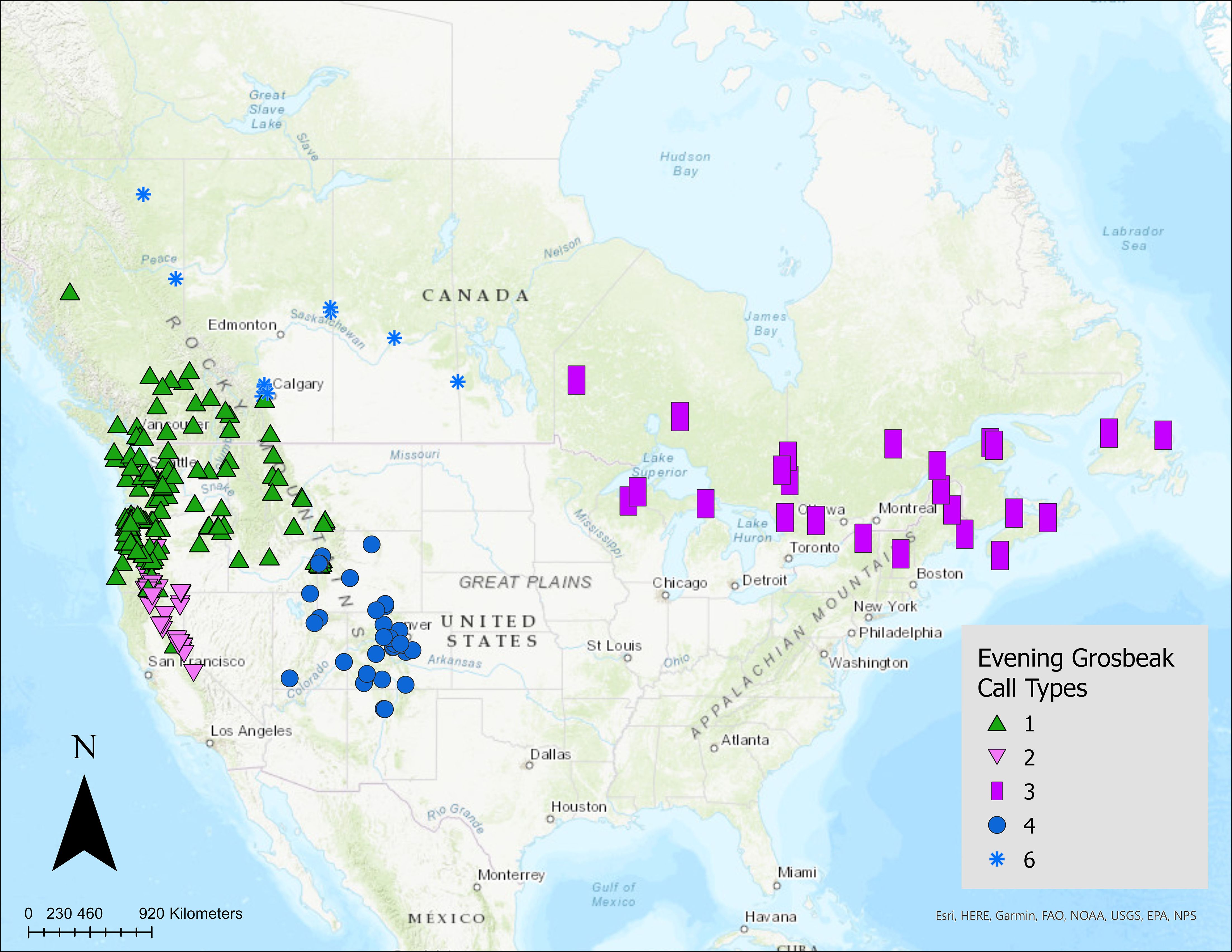
Figure 6. Evening Grosbeak call type breeding ranges. Map produced from all Evening Grosbeak recordings uploaded to the Macaulay Library during June-July that were identifiable to call type (n=307). Type 1 birds (n=189) are primarily in the Pacific Northwest, Type 2 birds (n=38) are primarily in the Sierra Nevada Mountains, Type 3 birds (n=26) are primarily in the Northeast, Type 4 birds are in the Rocky Mountains and Type 6 birds (n=12) are primarily in Alberta and Saskatchewan. There were no recordings of Evening Grosbeaks from Mexico during June-July in the Macaulay Library that were identifiable to flight call type. This is presumably where type 5 Evening Grosbeaks breed, but additional data are needed.
Importantly, not all flight calls clustered distinctly in our analyses. One cluster contained birds intermediate between the type 6 cluster and most type 4 flight calls. It contained the older type 3 birds, eight calls labeled as type 4 and two Alberta/Saskatchewan recordings. After ensuring no measurement errors were made with recordings in this cluster, we concluded that the group reveals either the incompleteness of spectrographic properties we included in our analyses, misdiagnoses of some calls to type or sufficient variability in calls that some cannot be readily diagnosed to type. Discriminant function analyses confirmed birds in this cluster were more likely to be misdiagnosed.
4.2 Geographic distribution of flight call breeding ranges
We updated the currently known breeding ranges of Evening Grosbeak call types based on flight call information presented here (Figure 5; Supplementary Figure 2). Type 1 is found in the Pacific Northwest and overlaps near its southern boundary with type 2 in the Sierra Nevada Mountains. Type 3 occurs in northeastern North America while type 4 occupies the central and southern Rocky Mountains. Overlap of the ranges of type 4 and type 1 are minimal but does occur in some years in the northern Rocky Mountains (e.g., Utah and Wyoming), USA. Type 6 occurs in Canada, especially in Alberta and Saskatchewan. We hypothesize the breeding distributions are relatively stable through time but the accumulation of additional recordings in public data archival sites will allow for stronger tests of that hypothesis as well as for tracking of patterns of migration and irruptive movements outside of breeding season months. Unfortunately, we have yet to obtain a single identifiable Evening Grosbeak recording from Mexico during June and July, which is where type 5 putatively breeds (all type 5 recordings, n= 7, are from calls recorded from December through May).
4.3 Trills
With the exception of a few specific situations (e.g., type 1 vs type 2), we found trills to be too variable to allow consistent identification of Evening Grosbeaks to type. Trill characteristics overlapped much more across the call types based on the characteristics included in our analyses. Our comparisons were simple, focused on four obvious variables. More sophisticated analyses that include additional measurements might reveal further differentiation. For example, some trills seem to have two phases, an initial one with an extremely fast trill rate followed by a longer phase with much slower rate of oscillations. Likewise, other observers (N. Pieplow, unpublished data) have observed similar phenomena, and speculated that some trill sequences might function as part of an Evening Grosbeak “song”. We did not quantify such characteristics and do not know if such patterns are consistent within call types. However, how trill sequences function in the context of sexual or group signaling and, if such sequences are distinct between different call types, may be important for determining the relative degree of genetic isolation found among call types.
4.4 How do the call types align with previously recognized subspecies?
Our Evening Grosbeak call types assessment was congruent with Grinnell’s morphological analysis of Evening Grosbeak subspecies (Grinnell, 1917) in which he recognized five subspecies but did not mention numbers of specimens he examined. An exception is with our finding of type 6 recordings in Alberta and Saskatchewan, Canada. We do not yet know if this call type can be reliably morphologically differentiated from other Evening Grosbeak populations. Grinnell did not examine birds from that geographic area and was working with a limited number of specimens collected primarily during winter when birds were likely away from their breeding grounds (Grinnell, 1917). However, one interesting and relevant observation from Grinnell (1917) was that he could not “distinguish between the birds of extreme southern Arizona and the [Veracruz] birds” (Grinnell, 1917, p. 21). He mentions examination of one specimen from Veracruz, Mexico, taken in June, 1864, which suggests that Evening Grosbeaks do occur in Mexico during the northern summer. Grinnell’s conclusions that Mexican birds may be a different subspecies overlap with those from Phillips et al. (1964), who suggested that Mexican birds were longer-billed but neither publications described vocalizations. As mentioned earlier, our analyses of Mexican recordings were limited to months between and including December and May, as no other months had recordings available at the time of our study. The possibility remains that some or all birds in southern Mexico could be migrants from Alberta/Saskatchewan as they currently have been recorded in Mexico only between December and May, possibly lingering into June if the specimen examined by Grinnell was not breeding. Additional recordings from Mexico, discovery of Alberta/Saskatchewan birds en route during migration periods or discovery that Mexican birds are indeed present year-round would help discriminate between alternative hypotheses for type assignments.
4.5 Priorities for future studies
Several additional studies would help to clarify understanding of the Evening Grosbeak call type complex. At the most fundamental level, it would be worthwhile to revisit the subspecies classifications characterized by Grinnell (1917) with greater spatial coverage of specimens. Such an investigation would help to evaluate the morphological variation identified by Grinnell (1917) and determine how it relates to call type vocal diversity more explicitly. Other key questions include identifying the extent of the breeding range for type 3 and type 6 birds, as well as mapping if/where they come into contact. Similarly, better spatial and temporal coverage of community-sourced Evening Grosbeak recordings will likely help to better elucidate the movement patterns of type 5 and type 6 Evening Grosbeaks, as well as all other types, and better aid in identifying possible future changes in structure of Evening Grosbeak flight calls. Another significant knowledge gap is basic data on the vocal diversity and general life-histories of Evening Grosbeaks in Mexico and the Hooded Grosbeak, a congener that has similar vocal characteristics.
Our assessment of the call types of Evening Grosbeaks is informed by the traits we included in our analyses. Additional information, such as sex or age of birds, could help reveal explanations for variation within and across calls in each call type. During our own field experience, we did not recognize any consistent differences in calls that could be attributed to sex but we did notice instances in late summer (August) when juveniles sounded different from typical adults. It is possible that males and females may differ in frequency characteristics of their calls, but this has yet to be evaluated empirically. We suspect that if such differences exist, they will be subtle and insufficient to lead to misdiagnoses of call types.
Furthermore, integrating genomic analyses with detailed studies of social behavior could greatly enhance our understanding of diversity and evolutionary divergence among Evening Grosbeaks. High-resolution genomic studies might reveal cryptic population structure and genetic differentiation that are not apparent from flight call characteristics alone, shedding light on the evolutionary history of these birds. Concurrently, a closer examination of social behaviors such as flocking dynamics, foraging strategies, and breeding interactions could also provide insights into processes that drive cultural evolution (or revolution) of flight call structure that might change faster than nucleotide sequences. By studying both the genetic underpinnings and the social processes, we can begin to unravel the mechanisms that produce, maintain, and modify the dialectal clusters seen in finch call types, ultimately contributing to a more comprehensive picture of their diversity and evolution.
Finally, despite being recognized as a species of management concern, few conservation actions have been implemented to manage populations of Evening Grosbeak. Our analyses of call type structure may help researchers focus on accumulating data on specific call type populations that appear to be declining most rapidly or most in need of additional fundamental biological information to better guide conservation decisions. For example, if type 5 and type 6 are call type populations distinctly different from other call type populations, they are likely to be the call types with the least ecological information available about them. Comparatively few recordings exist for either type, so even the extent of their geographic ranges remains poorly understood as well as whether or not they move seasonally or as irruptive migrants. Even for the better studied call types populations, such as types 1, 2, 3 and 4, basic biological information such as year-to-year variation in reproductive output, long-term trends in abundance, and annual survival are poorly documented. Given that geographic ranges of the call types overlap little or not at all during the breeding season, it is possible that knowledge of the specific call type populations being studied could help identify threats that differ among call types. Management actions tailored to circumstances specific to each call type may have a greater chance of being effective.
5 Conclusion
Based on our analysis of flight call characteristics, we conclude that six distinct Evening Grosbeak call types probably warrant recognition. Nevertheless, questions remain regarding the distinctiveness of the Mexican (type 5) and Alberta/Saskatchewan (type 6) populations. All Mexican recordings have been obtained between December and May, while Canadian recordings span the entire year, and since Evening Grosbeaks may overwinter in northern sites when food is abundant, the hypothesis that Mexican birds are migrants from Canada requires further investigation with additional data. Ultimately, our quantitative assessments demonstrate that flight calls can be reliably identified and mapped, which may be a useful tool for gaining insights into the movement and behavioral ecology of Evening Grosbeak call type populations. A more detailed understanding of the genetic and social interactions within these populations might also shed light on the processes that create, sustain, and alter the dialect clusters in finch calls, ultimately broadening our understanding of their diversity and evolutionary history.
Data availability statement
The original contributions presented in the study are included in the article/Supplementary Material. Further inquiries can be directed to the corresponding author.
Ethics statement
Ethical approval was not required for the study involving animals in accordance with the local legislation and institutional requirements because it was an observational study only; no animal handling.
Author contributions
WK: Writing – original draft, Formal analysis, Data curation, Methodology, Conceptualization, Investigation, Writing – review & editing. CC: Methodology, Writing – review & editing. SN: Data curation, Writing – review & editing. MY: Methodology, Data curation, Investigation, Conceptualization, Resources, Writing – review & editing. TH: Investigation, Conceptualization, Writing – review & editing. WR: Supervision, Writing – original draft, Formal analysis, Writing – review & editing, Investigation, Data curation, Conceptualization, Methodology, Funding acquisition.
Funding
The author(s) declare that financial support was received for the research and/or publication of this article. Bob and Phyllis Mace Professorship and Hatch Funds (WDR); Finch Research Network and Oregon State University College of Agricultural Sciences (WMK).
Acknowledgments
We thank the hundreds of community scientists and birders who have contributed recordings to the Macaulay Library and xeno-canto.org and trust that our work provides one example of why their efforts contribute to the collective advancement of knowledge about birds. We thank the eBird and Macaulay Library teams for facilitating acquisition of sound recordings. Our work was supported by the Bob and Phyllis Mace Endowed Professorship and Hatch Funds (WDR), the Finch Research Network, Oregon State University College of Agriculture Continuing Researcher Support Program and the ER Jackman Internship Support Program (WMK). Tara Kate Designs contributed schematic drawings of flight calls.
Conflict of interest
The authors declare that the research was conducted in the absence of any commercial or financial relationships that could be construed as a potential conflict of interest.
The author(s) declared that they were an editorial board member of Frontiers, at the time of submission. This had no impact on the peer review process and the final decision.
Generative AI statement
The author(s) declare that no Generative AI was used in the creation of this manuscript.
Publisher’s note
All claims expressed in this article are solely those of the authors and do not necessarily represent those of their affiliated organizations, or those of the publisher, the editors and the reviewers. Any product that may be evaluated in this article, or claim that may be made by its manufacturer, is not guaranteed or endorsed by the publisher.
Supplementary material
The Supplementary Material for this article can be found online at: https://www.frontiersin.org/articles/10.3389/fbirs.2025.1613273/full#supplementary-material
Supplementary Table 1 | Statistical evaluation of measurement error in characteristics of Evening Grosbeak flight calls (n=22). Mean ± SD for Tstart (time call started within a recording), Tend (time call terminated within a recording), Fmax (maximum frequency reached), Fs (frequency at start of call) and Fend (frequency when call ended) are compared in a randomly chosen sample of 22 calls measured twice by different researchers (Measure 1 vs Measure 2). Statistical differences in the samples were compared with a t-test assuming unequal variances.
Supplementary Figure 1 | Dendrogram from hierarchical cluster analysis (Ward’s method) showing groupings of flight calls labeled with geographic regions (2-letter codes for state or province) where each recording was made. Type 1 (green), type 2 (pink), type 3 (before the year 2000: orange; after 2000: purple), type 4 (dark blue), type 5 (brown) and type 6 (light blue).
Supplementary Figure 2 | Examples of variation in trills of each proposed Evening Grosbeak call type. Trills were identified to type based on co-occurrence in recordings with diagnosable flight calls and where no other flight call types were recorded.
Supplementary Data Sheet | Data matrix with metadata information.
References
Baptista L. F. (1977). Geographic variation in song and dialects of the puget sound white-crowned sparrow. Condor 79, 356–370. doi: 10.2307/1368014
Benkman C. W. (1990). Intake rates and the timing of crossbill reproduction. Auk 107, 376–386. doi: 10.2307/4087622
Benkman C. W. (2016). The natural history of the south hills crossbill in relation to its impending extinction. Am. Nat. 188, 589–601. doi: 10.1086/688904
PubMed Abstract | PubMed Abstract | Crossref Full Text | Google Scholar
Benkman C. W., Smith J. W., Keenan P. C., Parchman T. L., and Santisteban L. (2009). A New Species of the Red Crossbill (Fringillidae: Loxia) from IdahoUna Especie Nueva de Loxia (Fringillidae) de Idaho. Condor 111, 169–176. doi: 10.1525/cond.2009.080042
Cornell Lab of Ornithology (2023). Raven pro: interactive sound analysis software (version 2.0) (Ithaca, New York USA: Cornell Lab of Ornithology).
Drovetski S. V., Zink R. M., and Mode N. A. (2009). Patchy distributions belie morphological and genetic homogeneity in rosy-finches. Mol. Phylogenet. Evol. 50, 437–445. doi: 10.1016/j.ympev.2008.12.002
PubMed Abstract | PubMed Abstract | Crossref Full Text | Google Scholar
Duman K. W. and Hahn T. P. (2024). Sympatric breeding occurrence of two call types of Evening Grosbeak in Western Wyoming. Front. Bird Sci. 3. doi: 10.3389/fbirs.2024.1371155
Esri, Inc (2022). ArcGIS Desktop: Release 10.8.2. (Redlands, CA: Environmental Systems Research Institute). Available online at: https://www.esri.com/en-us/arcgis/products/arcgis-pro/overview.
Grinnell J. (1917). The subspecies of hesperiphona vespertina. Condor 19, 17–22. doi: 10.2307/1362452
Groth J. G. (1988). Resolution of cryptic species in appalachian red crossbills. Condor 90, 745–760. doi: 10.2307/1368832
Groth J. G. (1993). Evolutionary differentiation in morphology, vocalizations, and allozymes among nomadic sibling species in the north american red crossbill (Loxia curvirostra) complex (Berkeley, California USA: Univ of California Press).
Hending D. (2025). Cryptic species conservation: a review. Biol. Rev. 100, 258–274. doi: 10.1111/brv.13139
PubMed Abstract | PubMed Abstract | Crossref Full Text | Google Scholar
Jones G. (1997). Acoustic signals and speciation: the roles of natural and sexual selection in the evolution of cryptic species. Advances in the Study of Behavior 26, 317–354. (Boston, Massachusetts USA: Pieplow). doi: 10.1016/S0065-3454(08)60383-6
Keenan P. C. and Benkman C. W. (2008). Call imitation and call modification in Red Crossbills. Condor 110, 93–101. doi: 10.1525/cond.2008.110.1.93
Martin R., Rochefort J., Mundry R., and Segelbacher G. (2019). Delimitation of call types of Red Crossbill (Loxia curvirostra) in the Western Palearctic. Écoscience 26, 177–194. doi: 10.1080/11956860.2018.1564483
Martin R., Rochefort J., Mundry R., and Segelbacher G. (2020). On the relative importance of ecology and geographic isolation as drivers for differentiation of call types of red crossbill Loxia curvirostra in the Palearctic. J. Avian Biol. 51, 1–15. doi: 10.1111/jav.02358
Mikkelsen E. K. and Irwin D. (2021). Ongoing production of low-fitness hybrids limits range overlap between divergent cryptic species. Mol. Ecol. 30, 4090–4102. doi: 10.1111/mec.16015
PubMed Abstract | PubMed Abstract | Crossref Full Text | Google Scholar
Mundinger P. C. (1979). Call learning in the carduelinae: ethological and systematic considerations. Systematic Biol. 28, 270–283. doi: 10.1093/sysbio/28.3.270
Phillips A. R., Marshall J. T. Jr., and Monson G. B. (1964). The birds of arizona. (Tucson, AZ, USA: University of Arizona Press).
Pieplow N. (2019). Peterson field guide to bird sounds of western north america (Boston, Massachusetts USA: Houghton Mifflin Harcourt).
Podos J. and Warren P. S. (2007). The evolution of geographic variation in birdsong. Adv. Study Behav. 37, 403–458. doi: 10.1016/S0065-3454(07)37009-5
Podos J. and Webster M. S. (2022). Ecology and evolution of bird sounds. Curr. Biol. 32, R1100–R1104. doi: 10.1016/j.cub.2022.07.073
PubMed Abstract | PubMed Abstract | Crossref Full Text | Google Scholar
Robinson W. D., Nanau M., Kirsch W., Centanni C. T., and Clements N. M. (2024). Flight calls and trills of Evening Grosbeaks can be used to map movements and ranges of call types 1 and 2. Front. Bird Sci. 3. doi: 10.3389/fbirs.2024.1340750
Scott A. C. and Bekoff M. (1991). Breeding behavior of evening grosbeaks. Condor 93, 71–81. doi: 10.2307/1368608
Sebastian-Gonzalez E. and Perez-Granados C. (2025). Geographic variation in acoustic signals in wildlife: a systematic review. J. Biogeography 52, e15116. doi: 10.1111/jbi.15116
Sewall K. B. and Hahn T. P. (2009). Social experience modifies behavioural responsiveness to a preferred vocal signal in red crossbills, Loxia curvirostra. Anim. Behav. 77, 123–128. doi: 10.1016/j.anbehav.2008.09.016
Sewall K., Kelsey R., and Hahn T. P. (2004). Discrete variants of Evening Grosbeak flight calls. Condor 6, 161–165. doi: 10.1093/condor/106.1.161
Slater P. J. B. (1986). The cultural transmission of bird song. Trends Ecol. Evol. 1, 94–97. doi: 10.1016/0169-5347(86)90032-7
Slater P. J. B. (1989). Bird song learning: causes and consequences: Ethology Ecology & Evolution: Vol 1, No 1. Ethology Ecol. Evol. 1, 19–46. doi: 10.1080/08927014.1989.9525529
Sullivan B. L., Wood C. L., Iliff M. J., Bonney R. E., Fink D., and Kelling S. (2009). eBird: A citizen-based bird observation network in the biological sciences. Biol. Conserv. 142, 2282–2292. doi: 10.1016/j.biocon.2009.05.006
Swenson N. G. and Howard D. J. (2005). Clustering of contact zones, hybrid zones, and phylogeographic breaks in north america. Am. Naturalist. 166, 581–591. doi: 10.1086/491688
PubMed Abstract | PubMed Abstract | Crossref Full Text | Google Scholar
Toews D. P. L. and Irwin D. E. (2008). Cryptic speciation in a Holarctic passerine revealed by genetic and bioacoustic analyses. Mol. Ecol. 17, 2691–2705. doi: 10.1111/j.1365-294X.2008.03769.x
Wilkins M. R., Seddon N., and Safran R. J. (2013). Evolutionary divergence in acoustic signals: causes and consequences. Trends Ecol. Evol. 28, 156–166. doi: 10.1016/j.tree.2012.10.002
PubMed Abstract | PubMed Abstract | Crossref Full Text | Google Scholar
Wood C., Sullivan B., Iliff M., Fink D., and Kelling S. (2011). eBird: engaging birders in science and conservation. PloS Biol. 9, 1–5. doi: 10.1371/journal.pbio.1001220
Keywords: cryptic diversity, finch, flight calls, Fringillidae, infraspecific diversity, spectrogram, subspecies
Citation: Kirsch WM, Centanni CT, Ngo SH, Young MA, Hahn TP and Robinson WD (2025) Quantitative analysis of the flight calls and trills of Evening Grosbeaks (Coccothraustes vespertinus). Front. Bird Sci. 4:1613273. doi: 10.3389/fbirs.2025.1613273
Received: 16 April 2025; Accepted: 14 July 2025;
Published: 08 August 2025.
Edited by:
Eira Bermúdez Cuamatzin, Leiden University, NetherlandsReviewed by:
Cristian Pérez-Granados, University of Alicante, SpainDaniel Goldberg, Grand Valley State University, United States
Copyright © 2025 Kirsch, Centanni, Ngo, Young, Hahn and Robinson. This is an open-access article distributed under the terms of the Creative Commons Attribution License (CC BY). The use, distribution or reproduction in other forums is permitted, provided the original author(s) and the copyright owner(s) are credited and that the original publication in this journal is cited, in accordance with accepted academic practice. No use, distribution or reproduction is permitted which does not comply with these terms.
*Correspondence: William M. Kirsch, d2lsbGlhbWtpcnNjaDExMDlAZ21haWwuY29t
 William M. Kirsch
William M. Kirsch Caleb T. Centanni
Caleb T. Centanni Song Han Ngo
Song Han Ngo Matthew A. Young3
Matthew A. Young3 Thomas P. Hahn
Thomas P. Hahn W. Douglas Robinson
W. Douglas Robinson